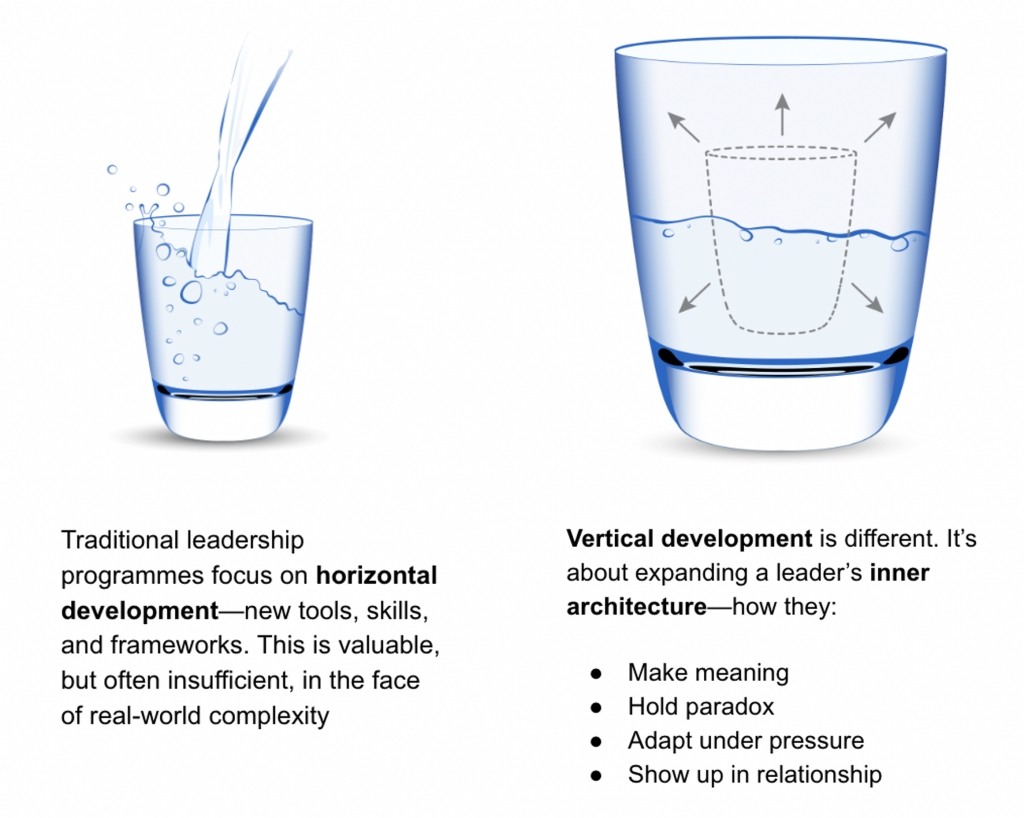The future of leadership: why vertical development is essential

The leadership shift we’re facing
Tomorrow’s leaders will need radically different capabilities than those of today. Disruption is relentless. The path forward is rarely clear. Time is short. Trust can be fragile.
Leaders must now:
- Spot leverage points in a complex system before taking action
- Hold multiple, even opposing, perspectives
- Balance drive with enablement
- Inspire and mobilise commitment in others
- Stay grounded in uncertainty
This isn’t just about learning more. It’s about thinking in fundamentally more complex ways.
Horizontal vs. vertical development

Most leadership programmes focus on horizontal development — adding skills, knowledge, and tools. This is useful, but it’s like installing new apps without upgrading the operating system.
Vertical development is different. It transforms how a leader thinks, feels, and makes sense of the world. It expands their capacity for complexity, agility, and adaptability across three dimensions:
- Head (Mental Agility): Holding multiple perspectives, asking better questions, and staying open to uncertainty.
- Heart (Relational Agility): Deepening emotional intelligence, empathy, and the ability to work across difference.
- Hand (Task Agility): Balancing when to direct and when to co-create, turning insight into decisive action.
This is the real shift — from learning new things to seeing with new eyes.

Five principles for accelerating vertical development
1. Learn in the work
Vertical development doesn’t happen in classrooms — it happens in live transformation. Leaders grow fastest when they cycle through action, reflection, and adaptation on real business challenges.
2. Build systemic perspective
Advanced leaders think at three levels at once:
- Organisation: Seeing patterns across the system
- Group: Navigating collaboration and trust
- Individual: Staying aware and resilient under pressure
This ability to shift between lenses allows leaders to mobilise the whole organisation, not just their own team.
3. Develop head, heart, and hand
Cognitive skill alone isn’t enough. Leaders must integrate thinking, feeling, and doing — flexing between directive and facilitative styles depending on the context.
4. Practice here-and-now learning
Great leaders learn in the moment. They can pause under pressure, step back to see the bigger picture, and adjust their approach in real time.
5. Make the invisible visible
Every leader and team has default communication patterns that shape decisions — often unconsciously. By surfacing these patterns, we expand the group’s repertoire, enabling deeper dialogue and better decisions.
The payoff
Leaders who embrace vertical development:
- Stay calm and grounded in volatility
- Create alignment without shutting down dissent
- Make better decisions, faster
- Build cultures of trust, learning, and innovation
This shift takes time and commitment — but the result is a leadership culture that can guide organisations through disruption and into a thriving future.
The future won’t wait. If you want a leadership team that can navigate complexity, inspire change, and mobilise the organisation, the work begins now.
Transformation starts here…
The future belongs to organisations that unlock the power of Collective Intelligence — feeling, thinking, and acting as one. Are you ready to build that capacity? Start the conversation with us.
